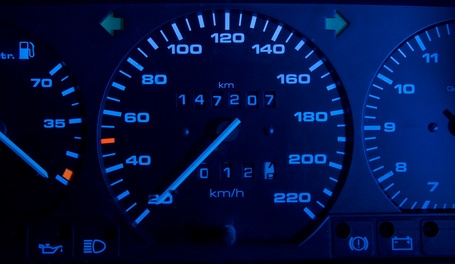
If you need to troubleshoot a Ford Ranger's engine and you don't know exactly where to start, the on-board diagnostic system can offer a tremendous amount of assistance. The Ranger's diagnostic computer runs a series of checks and tests constantly. Once a malfunction occurs, the system assigns it a code number. If it happens often enough, it will turn on the Ranger's check engine light. Computerized diagnostics, however, will never be the ultimate answer, however. If you use the system to make a list, it can shorten the amount of time troubleshooting entails.
Plug the OBD-II scanner's chord into the Ranger's Data Link Connection. This outlet serves as the entry point into the Ranger's diagnostic computer. You will find it beneath the steering wheel and somewhere between the left kick panel and the brake.
Switch the scanner on, if you do not own one that is set to auto-activate once a data stream is detected. OBD-II scanners are all different by brand, so always read and defer to the instructions contained in your scanner's manual.
Stick your key into the Ranger's ignition and switch to "On." You may own a scanner that requires you to turn the engine on. If so, do that at this time.
Enter a "Retrieve," if your brand of scanner is not prefigured to do that automatically. Since button layout varies by scanner, you will have to consult your manual in how to do that.
Copy the trouble codes onto a piece of paper, once the scanner has retrieved them. Then, scroll through the codes and look for ones with "pending" status. Copy those down too, but make them a lower priority. Trouble codes have occurred frequently while pending codes have not. Still, pending codes could gain "Trouble" listing, if they continue to occur.
Look up the OBD-II coding definitions in your scanner's manual. These definitions should be part of a longer list of generic OBD-II codes. Ford has separate, supplemental OBD codes that you will need to look up online. The Ranger's manual will not have them. Copy all coding definitions onto the paper with the code numbers.
Open the Ranger's hood. Begin at the top of your list, with the trouble codes. Investigate all the areas that correspond with those codes. Cross off the codes you eliminate from consideration. Move onto the pending codes and do the same.
Start the Ranger's engine and let it idle to it reaches operational temperature. This will happen quicker if the air conditioning is off. Then, turn the engine and electrical system off, but leave the key in the ignition.
Join the Ranger's Self Test Out and Self Test In connectors with jumper wire. The STO is a six port hub that is trapezoidal in shape. The STI is a single slot on a wire, located right next to the STO. Both can be found toward the rear of the engine compartment. One end of the jumper wire needs to go into the STI, the other needs to go into the bottom left "ground" slot on the STO.
Return to the driver's seat and turn the key in the ignition to "On," but you will need to leave the engine off.
Count how many times the check engine light flashes, and jot the number onto a piece of paper. Ford's pre-OBD-II codes (EEC-IV) are two digit numbers. The first number will be long flashes, followed by a pause. The second number will be quick, pulse-like flashes. For example, EEC-IV code 44 will four long flashes, a short pause, and four short flashes. Descriptions for these codes will have to be found online. Your Ranger's owner manual will not have them. The only other option is to buy a Ford Ranger Haynes Repair Manual.
Investigate the Ranger's engine. Begin at the top of your list and look at the engine areas that correspond with the coding descriptions. Scratch out codes once you have eliminated them from consideration.